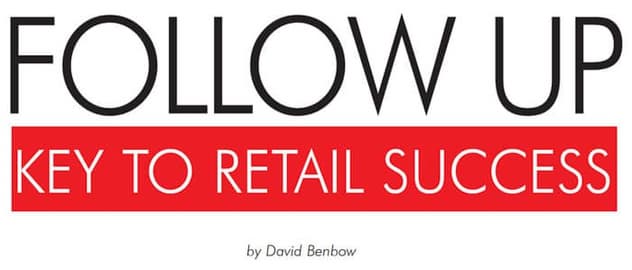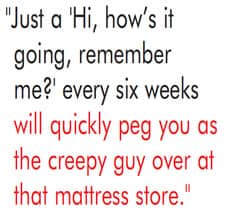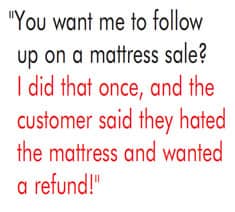
Build furniture and bedding sales by using a follow-up system to create top-of-mind awareness of you, as well as the products you sell.
Several days ago, I received a phone call from my website host. It was a follow up call. They don’t follow-up very often, which is fine with me. The gentleman calling was pleasant and in quite a chatty mood; probably to break the monotony of making endless follow-up calls all day.
Anyway, he began to ask me about my website, and my book, “How to Win the Battle for Mattress Sales, the Bed Seller’s Manual”. He was curious. Why would I bother to write such a book? Who would buy it, or use it? And, why would anyone read such a book? I explained that my book is a training course and instruction manual for retail salespeople (RSAs); especially bedding salespeople. He admitted that he understood why such a book was needed; commenting that most retail sales people he had encountered did not do a very good job. Then, he told me about an outstanding experience he and his wife had last year in a furniture store. They bought a famous brand motion sofa. He was impressed with the salesman’s knowledge and enthusiasm. They bought the sofa, and have been enjoying it now for about a year. They couldn’t be happier with it, he said.
I said, “I would really like to meet that salesperson. It’s rare to see that level of professionalism in our business. What is his name?”
He paused for a moment and said, “Uh, …I can’t remember his name.”
I asked, “Have you heard from him since you bought the sofa?”
He paused again, and said, “Mmmmm…Come to think of it, no, I haven’t. You know what else? I can’t even remember where we bought it.”
I responded, “So, he was this great salesperson, but he has not followed up with you, and now you do not even remember his name. And, you also said you don’t remember the name of the store. Let me ask you a question. How many sales do you think he has lost because he did not follow up with a happy customer?”
The website host rep agreed, “Yeah, I would have given him a lot of referrals.”

“And,” I replied, “You are still a good prospect to buy more furniture. Now do you see why I wrote the book? Most salespeople need to know how to follow up, why they should follow up; the rewards of having a strong follow-up system, and so on. So, your man made one sale, but how many more did he miss because of his failure to follow-up? I wonder if he does that with all of his customers?”
This is a true story.
Why Follow Up?
The previous section should have answered that question. The brutal truth about sales is this; you can be the greatest RSA in the world, know every nook and cranny of the store, its product, inventory, etc. You can be a magician with customers and close deals like Zig Ziglar. But, your success will always be limited to the here and now with walk-in UPS if you fail to develop a thorough follow-up system. In fact, I will even go so far as to say that an average RSA with a great follow-up system might have more long-term success than the sales whiz with a mediocre or non-existent follow-up system.
Types Of Follow-Up
There are actually several categories of follow up. What most people think of as “follow up” is giving customers status reports on special orders. Mattress sales are rarely special orders; “buy it today, sleep on it tonight!” But, furniture sales are often special orders, meaning that customers may wait many weeks for new furniture. If a customer has paid up front, I can tell you she is going to be restless and anxious waiting for her new furniture. A professional RSA stays on top of these orders and keeps customers up-to-date. Customers like to hear from RSAs, even if there is no change in the status of an order. That way, she knows the store has not forgotten about her.

Another category of follow up goes like this. People may come into your store looking for something your store does not carry, nor does any other store within a five hundred mile radius. But, maybe your store can find and order the item the person wants. Finding this special item may require some effort. The professional RSA who does the research can follow up once the item is found. And, professional RSAs will follow-up, even if the item hasn't been found yet, just to let the interested party know he or she is still looking.
Thank-You Notes
Now we’ll talk about a category of follow up that is preached in every sales book I’ve ever read. It is one that hardy any RSAs actually do. I am talking about thanking the customer for the sale; AFTER the customer has the product in their home. It’s a mantra with every sales trainer; “Send the customer a post card thanking them for the sale!”
Now, is sending thank-you notes a good idea? Yes, IF. I say “if” because if the RSA sends out one card, and does not keep following up long term, it is probably a waste of time. It is a lot of trouble and some expense to send out thank you notes to every buying customer. Post cards cost money, postage costs money, and the time spent filling out the post cards and mailing them may be the most expensive component of all. Let’s do a little arithmetic. Between the card and the postage, each mailing will cost at least fifty cents. Let’s say the salesperson makes five sales per day. Over a work year of 250 days, that is 1,250 sales per year. Mailing post cards for that kind of sales volume would cost $625 per year. That really doesn’t sound too bad by itself, but consider this; how long does it take to fill out, stamp, and mail 1250 post cards? Even if you spend only three minutes per post card, you have spent over 60 hours per year just mailing thank-you notes. And, that is just for ONE thank-you note for each new customer.
Please do not get the idea that I am opposed to sending out thank-you notes. I am very much in favor of them. But, if you think one thank-you note will give you top-of-mind awareness forever with the customer, you may have an unrealistically exalted opinion of your presence and charisma.
On the positive side, how great is it to have a data base of 1250 sales prospects after only one year? Remember, OLD customers become NEW sales prospects.
Top-Of-Mind Awareness
That brings us to the next and possibly final category of follow-up; the long term, “become a virtual member of the family” type of follow up.
Long term, continuous follow up is, in my opinion, the foundation of lasting success in our business. With this type of follow-up, professional RSAs remain in steady and frequent contact with the customers. How steady and how frequent? RSAs should have some kind of communication with prospective customers at least every six weeks; for the rest of the RSAs career or the life of the customer. Only with this kind of follow up, will the RSAs name become fixed in the customer’s mind as the go-to person for new furniture. In advertising, they call this “top of mind awareness.”

RSAs should include some interesting information with each follow-up. Just a “Hi, how’s it going, remember me?” every six weeks will quickly peg you as “the creepy guy over at that mattress store; I need to call-block his number and spam his emails.” Professional RSAs maintain files listing their customers' interests and plans. Information such as the age of mattresses and sofas, and future plans the client related during the qualifying stage should be noted. That way, when follow-up calls, emails or texts are made, exciting new information addressing possible needs can be included. Ideally, customers should be delighted to get communications from RSAs. “I got a text from Bob at Never-Forget-Us-Furniture and Mattress! They just got in these great new adjustable bed bases that I’ve been waiting for!” Now, how hard will it be to make that sale? This kind of easy sale, over and over again, down through the years, is only possible with a powerful follow-up system.
Smart RSAs who use this kind of follow-up can consider prospects to be clients, not just customers. The term client implies a more long term buyer relationship.
Now, the skeptical mattress RSA might whine, “You want me to follow up on a mattress sale? I did that once, and the customer said they hated the mattress and wanted a refund! I’ll never do that again! Not only that, it will be eight to ten years before they need another set. You want me to follow up for ten years with no sales?” Let me answer both questions. Yes, it is especially important to take care of an unhappy customer. One unhappy customer can poison your attitude and your sales. And, don’t ever think that bedding buyers will not be repeat customers. They will buy guest room beds and kid’s beds and second home beds, and will refer their friends to do the same thing.
How To Follow Up, Efficiently
Looking back at my “post card follow up” paragraph; it’s not hard to imagine that follow up has the potential to become a massive burden to the career RSA who has accumulated an impressively large clientele. It takes a lot of time to manage a client roster or data-base like that. Some stores have a Customer Relations Management (CRM) department to handle that task and free up RSAs' sales time. Check out the article on machine learning later in this issue. It's an eye-opener and a potential game-changer for effective follow up. The problem with leaving follow up to the store’s resources right now and for most retailers, is that it removes the direct contact between an RSA and her clientele. I think it’s great if stores have a corporate follow-up system, but for many of these follow-up systems, RSAs will be well advised to maintain a personal follow-up system of their own. Without that, long-term rapport with customers can be lost.

We all know that working at retail involves a lot of slow and down time. Certain days of the week can seem endless, especially after big sales are over and done. This down time is the perfect occasion for follow up. If you have a large database of prospects, you will need an efficient way to make use of it. You can use a card file if you like, but modern CRM software improves on that. Since most successful, professional RSAs are well-organized, efficient, time-optimizing people, they will most likely want the best type of follow-up system.
CRM Software
There are a lot of software applications available for busy RSAs. I will not recommend any particular product. I only mention it to make the reader aware of their existence. Just Google "sales follow-up systems" and you will see many applications... some free. There are, as well, furniture and bedding specific CRM platforms tailored to our industry you may want to investigate.

I suggest using some downtime to research these packages to see which, if any, can help your business.
Principles Of Follow-Up
Let’s cover some general principles of follow up. What do we want to accomplish? How much trouble are we willing to go to? How easy is our follow-up system to use? Are we going to sustain our effort, long-term; or will we grow tired of going to all the trouble? Long-term follow up may require more self-discipline than any other aspect of retail sales.
The Database
Here are a few suggestions for data items/fields RSAs should include in their databases. Obviously you need name, phone number, mailing address, email address and any social media your prospect uses. Always get the customer’s permission to contact them. It shouldn’t be hard if you make your communications informative and exciting. If you read my article in the January/February issue of Furniture World, you may remember to, “Give them an opportunity to buy.”
Also be sure to add the following information:
1. Has the prospect made any past purchases from you or your store? If so, when were these purchases made, what did they buy, and how much did they spend?
2. What are the prospect’s wants and needs? Part of qualifying any prospective customer is to find out what future needs and wants the customer is dreaming about. Is she thinking about a new bedroom group, or a mattress for an expected addition to the family, or maybe outdoor furniture for a new patio?
3. Assign an “urgency” rating to each customer. Your data base will include:
- UPS who have come into the store, but did not buy.
- Contact information for people you have met but have not necessarily visited your store. Each of these persons should have a “warmness” code to show how interested they are in a new purchase.
Past customers are often your best prospects, but even casual contacts can become very warm, very quickly.
This “urgency” code will be a rapidly moving target if you continually maintain your data base and stay on top of your business.
Your “warmest” prospects probably should deserve most of your attention, but don’t ignore your tepid or cold files. Don’t let anybody on your list forget who you are.
4. Keep a contact calendar on each listing in your data base. Make sure you note:
- When you attempted tocommunicate.
- If you made contact.
- The results of the contact.
- The next time you need to contact the prospect.
Each contact with your prospect should generate an update to the prospect’s urgency status. For example, you may discover that a random acquaintance you made in the frozen foods aisle of your supermarket needs a new mattress by the weekend. That’s how a contact becomes a paying customer, hopefully for the rest of your career.

In your contact calendar, note what you told the prospect and what she told you. Vary your message. Make it informative, exciting and different each time. There is an old saying we don’t seem to hear much anymore, “Variety is the spice of life.” It is also the spice of RSA-prospect communication. Tell your prospects about all new store promotions, new merchandise, new finance options, etc. The list is endless.
Prospect Feedback
All of the above ideas depend on communication. We’ve already discussed post cards, telephone calls, emails and texting. There are numerous Social Media avenues for RSA-prospect communication as well. You are probably familiar with the various social media options, but if not, find out how to use them for business purposes and incorporate them into your system. I personally think that two-way communications are preferable to just posting or tweeting. Perhaps it’s more time consuming, but there's the potential for dialogue and greater feedback. With post cards, and a lot of email communications, you won't get a response. Nor will you be able to know if it reached its destination, or had the desired effect. Ultimately, you must have feed-back from prospects in order to know how close they are to becoming paying customers.
Summary
One of the big reasons for follow up is that, as the customers and prospects in your database get to know you better, and rely on you for their furniture needs, they will also recommend you to their friends and neighbors. This is how you build a network of long term customers.